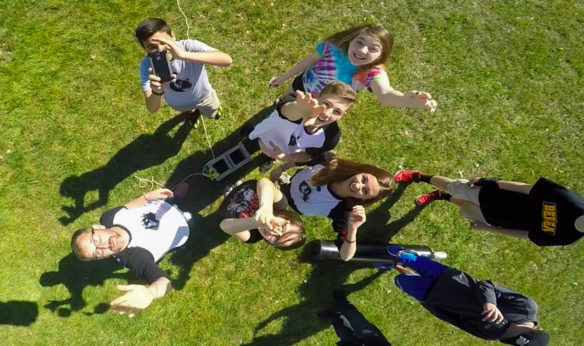
Joshua Woodward, bottom left, a chemistry/physics teacher at Berea Community High School, and his students say goodbye to a high-altitude weather balloon they launched in April. The launch and the balloon, fitted with three cameras, data recorders and a GPS tracker, was a project-based learning experience for his students.
Photo courtesy of Joshua Woodward
By Kevin Crump
kevin.crump@education.ky.gov
Berea Community High School students planned and carried out an investigation that took place above their classroom. Actually, 107,000 feet above their classroom to be exact!
Joshua Woodward’s Integrated Chemistry/Physics Honors students launched a weather balloon on April 16. Aboard this weather balloon were different devices for recording data, a radio transmitter with GPS units and three cameras. All of these devices were housed within a cooler attached to a parachute for retrieval.
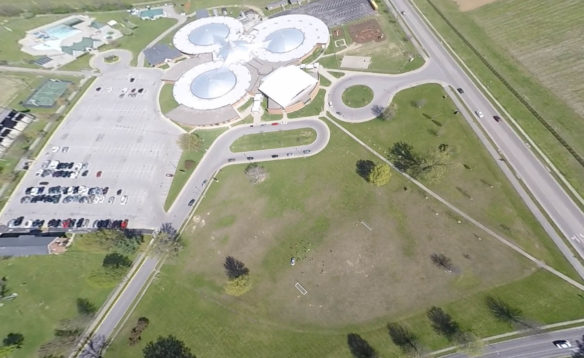
Almost a minute after the launch of a high-altitude weather balloon by Joshua Woodward’s students at Berea Community High School, one of the cameras on board snapped a picture of the school.
Photo courtesy of Joshua Woodward
The weather for the launch was perfect. As the balloon reached an upper level change in wind direction it took off to the west, as predicted, until out of sight. The focus then turned to receiving data transmissions and retrieval of the cooler. A car with Woodward and his retrieval team took off.
“Retrieval was a big unknown, but ultimately followed the script extremely closely,” Woodward said. “The tracking updates were coming in every minute, and we saw an altitude of 106,700 feet followed by one at 95,000 feet. The balloon had burst.
“We had to drive back and forth a bit as we dealt with poor signal strength, but as we got close to where we thought it was, a student saw it in a tree top across a valley. It was remarkably quick to find the landowner and hike to the exact spot, well, 60 feet below the exact spot. Gratefully, the landowner was willing to cut down the tree it was stuck in and we had our balloon back.”
The data, video and pictures were incredible. The aerial shots of Berea, Madison and Rockcastle counties were crystal clear. Even better were the images from the highest point, where you can see the curvature of the Earth and the darkness of outer space.
Woodward said he saw experiments being conducted in space on behalf of schools and this gave him the idea of high-altitude balloon flights. He wanted a project-based learning experience for his students that took them outside the classroom. There was a small red tape battle with federal authorities to obtain launch approval, but Woodward said it was no problem compared to the experience his students and parents received.
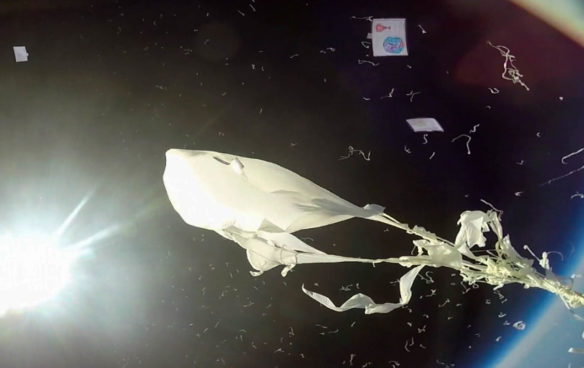
The high-altitude weather balloon launched by Joshua Woodward’s students at Berea Community High School burst when it reached 107,000 feet. The sun and the curve of the Earth are visible in the background.
Photo courtesy of Joshua Woodward
Woodward had to file a Notice to Airmen with the Federal Aviation Administration to warn pilots of the balloon’s flight. To use the radio transmitter, he had to earn a radio technician’s license from the Federal Communication Commission that involved very specific rules, regulations, and knowledge of electronics and electromagnetic principles. If you search his call sign, KM4SKJ, you can find many of the mission details.
The cost of materials was a concern at first, but Woodward set up a GoFundMe account. Parents, businesses and others were able to help by making donations. No financial help was needed by the superintendent or school board.
“One of the most important aspects of the project, in my mind, was the use of (student) committees to organize student contributions.” Woodward said. “The traditional way to incorporate collaboration is to form groups of four, maybe assign roles, and say go. The host of problems are well-known, namely some students taking on more of the work and learning than others.
“I was looking for a more authentic format for experiencing and learning collaboration. Integral to my plan was the idea that the groups would have to report to and request information from the other groups.”
An administrative committee wrote the grant, applied for various permissions and completed other bureaucratic tasks. A design committee decided on how to build the craft, designed the camera placements and experiments, and built the structure. A research group looked up information for any other committees.
A launch team was responsible for planning the launch site, predicting the flight path and developing a procedure for launch day. A media team was responsible for promoting the project for fundraising, as well as educational purposes. They also took the job of educating the school and community about the project’s goals.
“A member of each group served on the executive committee to facilitate communication between the committees and myself,” Woodward said.
Woodward said the instruments onboard – a single probe recording temperature and pressure combined with two GPS units – captured the altitude, latitude, longitude, groundspeed, temperature and pressure every 6 seconds.
“We also included a simple experiment meant to determine the expansion of air,” he said. “Several normal balloons filled to increasing volumes were meant to pop at altitudes we would be able to record. We were going to use that information to determine a relationship between altitude and volume. Alas, none of the balloons popped, but instead managed to leak air slowly. We haven’t figured that one out yet.”
When asked about the science and engineering practices his students demonstrated during the project, Woodward said he planned for each committee to have a different experience.
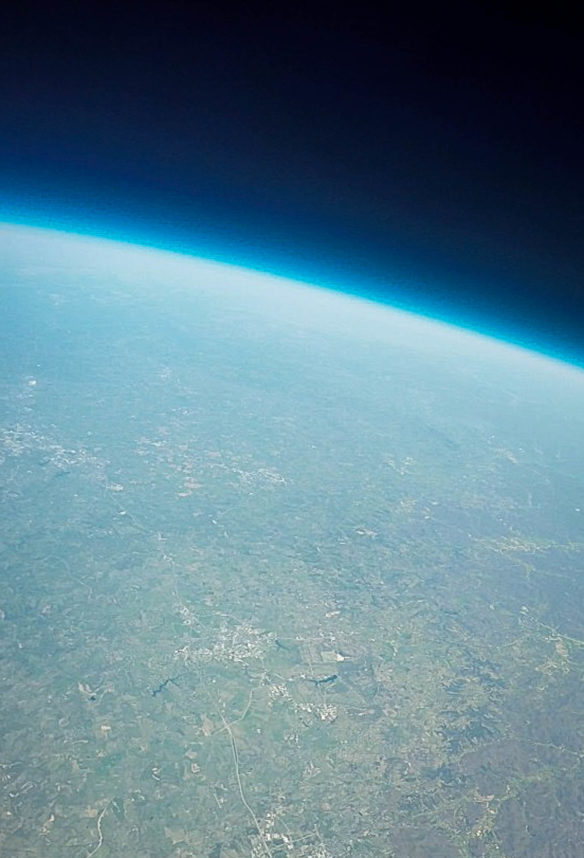
At an elevation of more than 100,000 feet, cameras carried by a weather balloon launched by Berea Community High School students capture the curvature of the Earth and the darkness of outer space.
Photo courtesy of Joshua Woodward
“Honestly, I can’t think of a science and engineering practice that was not demonstrated in this project. There were just so many facets to the project, and in each I put a premium on using data and data analysis to make decisions and then communicating those decisions to the group,” Woodward said.
Woodward said his students were able to demonstrate their ability to be problem solvers.
“My favorite example of designing a solution was in trying to get our secondary GPS unit to work correctly,” he said. “The concept we discovered was that the GPS unit has a directional antenna that must face the satellites. No matter how our craft landed, we needed the antenna to face up. The various strings, nets, hamster balls and finally, a half PVC/half hamster ball gimbal, was an amazing progression of designing solutions.”
During each phase of this process, students were able to blend different crosscutting concepts as they progressed though patterns, causality and systems. This three-dimensional approach to project-based teaching allowed students to take ownership of the investigation and demonstrate new science and engineering skills.
But the lesson did not end at the launch. Woodward said the students continued to investigate after the launch and retrieval.
“We still plan on developing a model to explain air resistance in relation to mass, air pressure, velocity and whatever this ‘thinness/thickness’ of atmosphere means,” he said after the launch. “That is a question, by the way, that the students are still defining and I’m letting them pursue the answer.”
You can see more pictures, videos and details by checking out Woodward’s GoFundMe page here.
Kevin Crump has been in science education for 23 years. He was a middle school science teacher in Fayette County before joining the Kentucky Department of Education in August 2013. He also has taught high school physics and Earth/space science, along with graduate level courses for the American Meteorological Society. He is a graduate of Eastern Kentucky University.

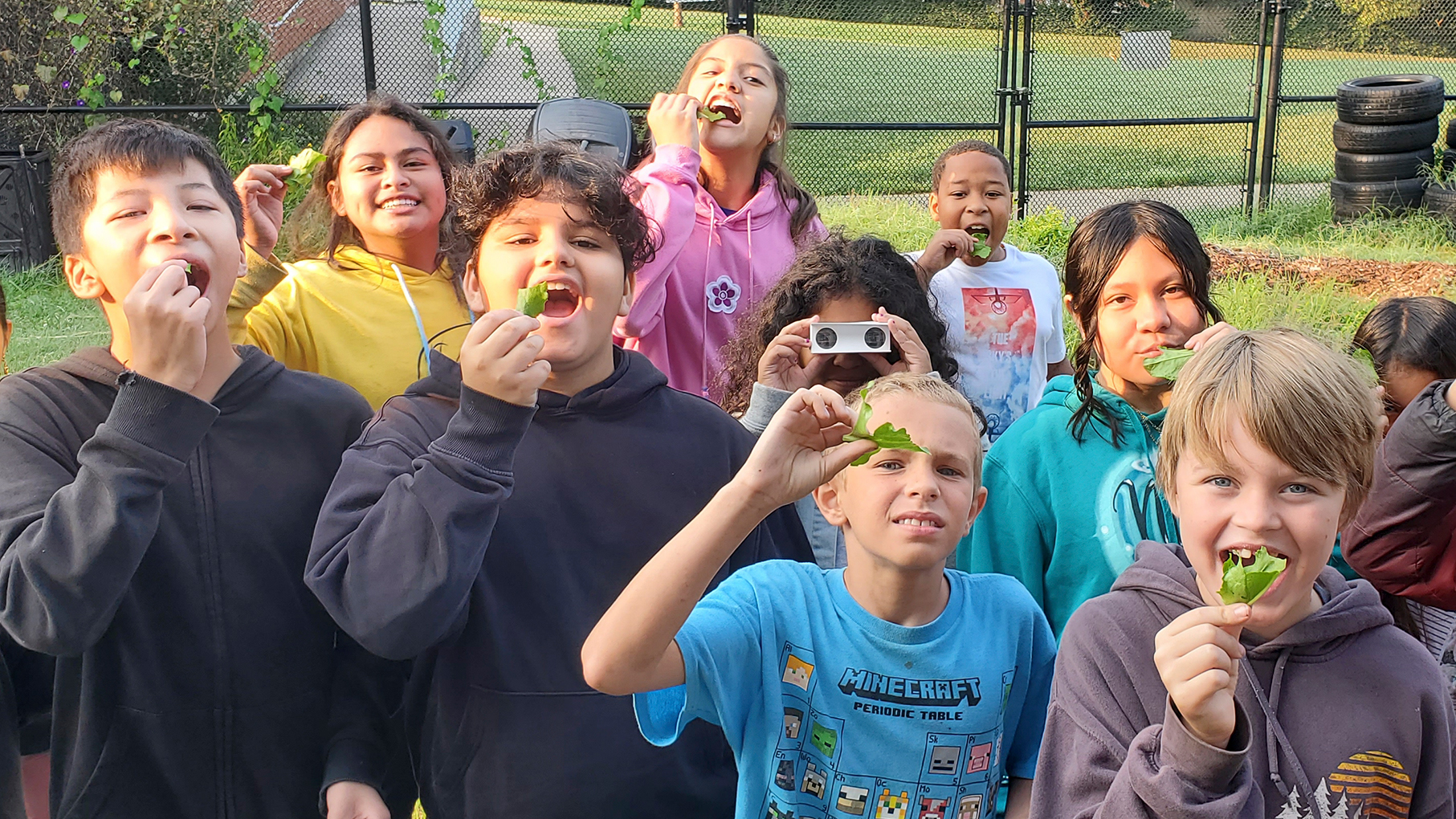
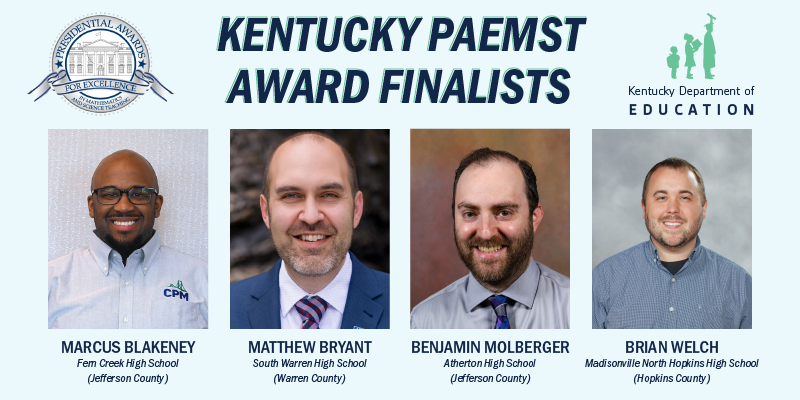
Leave A Comment